by Dale Haskin
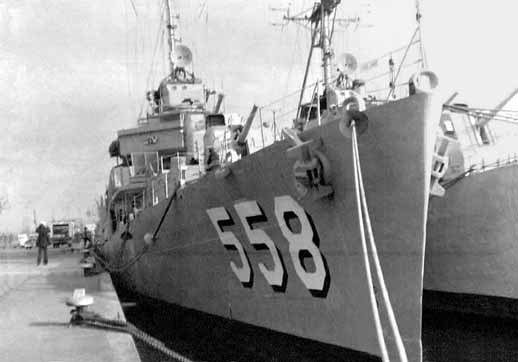
Starboard bow close-up of the ship tied up at the dock in Melbourne Australia

| The USS Laws was a Square Bridge Fletcher Class Destroyer commissioned in November 1943. She is unique in that she retained her original appearance throughout her career. The Laws was a well maintained ship. During its combined 15 years of active service, it received 9 battle stars for action in W.W.II and 2 battle stars plus the Sigmon Ree Presidential Unit Citation for Korean service. | |
| The photo on the right is the aft view down the starboard side of the
ship taken from the open bridge, outboard of the flag bag.
The names of the paint colors used at that time were "Haze Gray" (used on all vertical surfaces) and "Deck Gray" (used on all horizontal surfaces). The small areas of orange color that appear on various surfaces are a zinc chromate anti-corrosion surface preparation commonly called "red lead" that have yet to be painted over. Corroded surfaces were first chipped clean, a coat of linseed oil applied, followed by red lead and then the appropriate color paint. A well maintained ship will always have visible patches of red lead. |
for larger image. 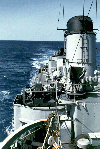 |
| Forward view up the port side of the ship taken from the director deck behind mount 53 (visible in the foreground). Note the round "dog house" on the torpedo mount. |
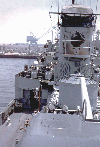 |
| This shot was taken during our approach to the USS Boxer for refueling
in 1956, and it shows fairly accurate haze and deck gray colors along with
the deck tread pattern on the bow.
You can also see that, except when firing, gun muzzles are fitted with gun plugs and additional canvas covers to protect the rifling from exposure to salt water/corrosion. In one of the model ship articles that I read, the modeler seemed to think it was more realistic to drill a hole in the end of the molded plastic barrel. On the real ship, no one would ever see it! |
 |
| This is a fairly detailed shot of the Captain's gig, its boat davit and rigging. Note the varnished wood gunwale and deck and the painted canvas on the collapsible top. Although you can't see it in this photo, the gig has a black waterline about 6 inches wide and the bottom of the hull was the same olive drab anti fouling paint as was used on the ships hull. There was room for individual differences in how each ship painted its motor whaleboats. On some, the bottoms were completely black. On others the Captain's gigs had their canvas tops painted white, while still others had a white, rounded fiberglass hood over the forward part of the gig. The openings on these hoods were usually highly decorated with elaborate knots made of white line hanging from the top of the openings. Note the hanging Gripes used to secure the boat from movement on its boat rests (or from swinging as the ship rolled, if not on its rests) and the knotted life lines (commonly called monkey lines) hanging from the span line between the davits. |
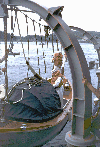 |
| This is a scan of an old black and white print from a 1957 photo I took while on the cross tree of the mast inspecting the surface search radar antenna. The Tender at the left is the USS Prairie (AD15). The destroyer in the center is the USS Stembel (DD644) and the one on the right is the USS Laws (DD558). Both destroyers are Fletcher class, but you can see that the Stembel has had its mount 53 replaced by a gun director and supporting structure during its conversion from 40 mm AA weapons to rapid fire 3 inch guns. The Laws was not converted and retains its aft mounted, forward facing 5 inch/ 38 cal. gun mount (mount 53 where the "5" stood for gun size and the "3" stood for the number of the gun mount in sequence from the bow). |  |
| Looking at the main decks you can see that the deck treads
have been replaced by skid resistant walkways. This process of conversion
took place over a period from late 1956 through the first half of 1957.
Deck treads provided limited skid resistance, wore out relatively quickly
and were difficult for the boatswains mates to maintain and paint around.
Their replacement consisted of large, sharp edged grit embedded in a bonding
agent that was spread within established borders on the deck and painted
deck gray after it had cured.
You can see the torpedo mount on the Stembel with the tube extensions folded back. This was required for space limitation reasons when the mount was positioned in its fore and aft locked position. These extensions were necessary during firing as they supported the torpedo's weight for a greater distance, allowing them to clear the ship's side as they dropped. On the fantail of both ships you can see the single depth charge launching rack with a smaller rack alongside it for carrying additional depth charges. I noticed a few striking differences between the model of the USS Fletcher and the ships I served aboard. For example, the early Fletcher had two torpedo mounts, whereas it later had the forward mount removed and a quad 40mm mount placed on each side of the ship in that location. The ship also had twin rudders, rather than the single one shown on the model. The bottom of the ship below the waterline was painted with an anti fouling paint that was about the color of glossy olive drab (not red) in the 1950s. I had the opportunity to closely examine the bottom of the Laws and three others while they were in dry-dock at Hunters Point Naval Shipyard, San Francisco. |
|
|
|
|
| It's 1957, somewhere in the East China Sea, the Laws is on the starboard side of the Lexington conducting a highline transfer of personnel, prior to the first ever refueling from the port side of an angled deck aircraft carrier, proving the feasibility of refueling two destroyers, simultaneously (one to port and one to starboard). After transferring technical advisers to the USS Lexington, the Laws proceeded to the port side of the carrier to refuel (next photo). |  |
| Port side refueling must be accomplished at a greater distance from the side of the carrier to avoid collision with the protruding angled deck. This, in turn, requires longer refueling hoses with more weight suspended between the ships. Under these conditions there exists a greater chance of the fuel lines parting if sufficient slack is not provided as the ships roll in opposite directions or, if the fueling hoses are allowed to drag in the water because of too much slack as the ships roll toward one another. The increased distance between ships introduced further steering difficulty for the destroyer by placing it more directly in the carrier's bow wave. This, it was found, could be compensated for by increasing the speed of both ships about two knots beyond normal refueling speed. |  |
| Stern view from the O-1 level of the after deck house. The man standing in front of the dark canvas spread over the railing is occupied in the normal routine of dumping garbage off the stern. To the left side of the stern chock in the photo you can see the deck mounted stack of the below deck mounted smoke generator. Most of these units had been removed from other destroyers by this time. Also note the chipped area on the main deck being prepared for application of a new anti skid surface material. You can see that the top wire rope of the ship's railings is wrapped and painted. In this case they are wrapped (served) with small diameter fiber line (small stuff) and painted white. Other ships did the same thing, or they wrapped the top wire rope with canvas. In any event, they were painted one of a number of colors selected by the ship (white, black, deck gray or haze gray) Even the safety chain across the ladder opening in the foreground railing is wrapped and painted. You can also see the additional 3/8 inch wire rope "lifeline" that is installed outboard of the main deck walkways when the ship is at sea. You can see one end of the lifeline attached to the depth charge rack. The lifeline was never wrapped. |  |
| These are Mk 15 torpedoes, the old gun destroyer's main battery (its 5 inch guns were the secondary battery). This trainable mount houses 5 torpedoes, the number fired in a normal spread against a surface target. The torpedo is 24 feet long by 21 inches in diameter and weighs 3,800 lbs. ( 800 lbs. of which is the torpex warhead). You can see that the detonators are not in place on the bottom side of these warheads. |  |
| A 1956 Armed Forces Day "dress ship" at the San Diego Destroyer Base, with the Laws nested between two modified Gearing Class DDRs (USS Chevialier DDR 805 and USS Hanson DDR 832). |  |
| Here is a vertical shot from the forecastle showing some of the ship's Ground Tackle in the foreground. This image is sharp enough to discern considerable detail, such as the ship's campaign ribbons, the optical range finder barrels on the main gun director and the fact that the 5 inch guns are off centered in their mounts about one foot to the starboard side to allow more space on the opening (port) side of the breech mechanism for the projectile and powder men to work. Note also the muzzle plugs in the barrels of the dual purpose 5 inch / 38 caliber guns and the unpainted, grease coated natural metal finish slide cylinders (the part of the gun that rests in the slide and moves through it in recoil), visible as an approximately 24 inch long section of the approximately 16 foot long barrel (chase) as it emerges from the mount enclosure). Barrel length for 3 inch and larger guns is determined by multiplying the projectile diameter in inches by the caliber ( i.e., 5 inch x 38 caliber equals a barrel length of 190 inches). | 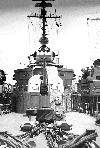 |
| USS Laws Links:
Navsource DD-558
page
|
|

© ModelWarships.com